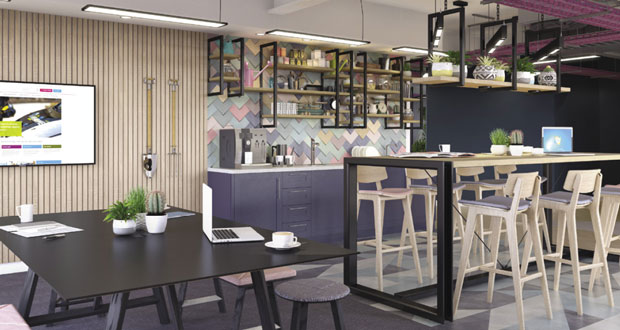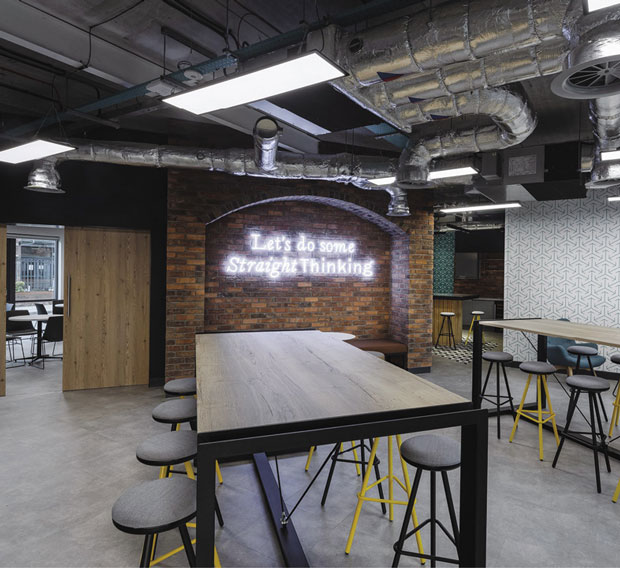Homogeneity
The success of the hub and spoke model is determined by the quality of the employee experience – and perhaps more importantly the homogeneity of experience across locations. In practical terms this means ensuring that employees always have ‘brilliant basics’ and use the same process to sign in, log-in, access printers and use collaboration tools wherever they are – whether it’s the hub, a spoke or at home. This need for remarkable consistency should also include the look and feel of the design to the quality of the coffee and be supported with employee guides to ‘sell’ the experience.
Technology
Technology is integral to the hub and spoke model as it enables employees to move freely between spaces without compromising productivity or connectivity. As such investment in technology needs to include infrastructure as well as tools – this will help FMs to manage the workplace as an asset and demand for different resources, as well as fulfil some duty of care responsibilities, particularly in relation to where employees are.
On a day-to-day level, this requires ‘plug and play’ capability in all locations, with access to power, connectivity and collaboration tools as well as single platform workplace booking systems to ensure parking, desks and meeting rooms can be allocated with a swipe of a finger. FMs often have the best vision when it comes to user experience – but IT will know what the buildings’ and systems’ capabilities are. The success of the hub and spoke model relies on these roles working together.
Act Now
 The timing of lease breaks and the market availability of space may limit formal downsizing, office moves and sublets, but changes to the workplace are necessary now because our behaviours have already changed. The intelligence from the workplace and needs analysis will identify where to prioritise efforts and investment. Learning lounges, high tech collaboration hubs or cafes could be added in place of unused desking and boardrooms, or perhaps un-used spaces could be offered up to community projects or as incubator spaces. Employees expect the workplace to support them – if it falls short, or doesn’t offer the experience they’ve been lacking, the search for flexibility and choice may lead them elsewhere.
The timing of lease breaks and the market availability of space may limit formal downsizing, office moves and sublets, but changes to the workplace are necessary now because our behaviours have already changed. The intelligence from the workplace and needs analysis will identify where to prioritise efforts and investment. Learning lounges, high tech collaboration hubs or cafes could be added in place of unused desking and boardrooms, or perhaps un-used spaces could be offered up to community projects or as incubator spaces. Employees expect the workplace to support them – if it falls short, or doesn’t offer the experience they’ve been lacking, the search for flexibility and choice may lead them elsewhere.
Flexibility
The desire for flexibility – at both a corporate and employee level – is a major driver of post pandemic workplace change. With rising real estate costs and limited space in cities, it’s not surprising the average length office lease is steadily falling and coworking spaces are proving popular. Part of the appeal of the hub and spoke model is that it helps businesses to break away from traditional office arrangements in favour of more flexible alternatives – smaller offices on shorter terms, partnered relationships with landlords and spaces that can be reconfigured easily to suit changing needs and occupancy levels. Some of our clients are buying employees membership at local coworking spaces to achieve this and in recognition that not everyone can work effectively at home too.
The need for flexibility must also recognise the individual employee’s experience. For example while working from home we’ve had control over our environment. But moving back into a shared office will mean much of that is relinquished. Ensuring that the workplace is rich in choice and availability of resources is an important way to remedy this.
The pandemic has accelerated the pace of change and the need to do things differently. It has put every aspect of how and where we work under the microscope and pressed the reset button. Choice, autonomy and flexibility are now critical to the future employee experience and importantly to a business’s future real estate strategy too. For FMs and business leaders it’s time to reinvent the workplace – not as somewhere employees have to go, but as somewhere they actively choose to be. The hub and spoke model opens up a new realm of possibilities and puts the importance of a flexible employee experience on the centre stage.
LOOKING AHEAD
We see from our 2021 data that a work setting ratio of 10:7 will suit peak requirements for the organisations that we have engaged, representing a 70 per cent occupancy compared with pre-pandemic use.
A work setting ratio of 10:5 will help to support an average utilisation across the week for most organisations representing a 50 per cent occupancy compared with pre-pandemic use.
During our initial lockdown surveys in 2020 we found that employees expected to be in office 1-2 days a week upon their return. 2021 data suggests this has changed to an expectation of 2-3 days a week in the office.
There is a reduction in the percentage of overall space required for desks to 40 per cent of the total area, the remaining space being utilised for alternative work settings, collaboration and supporting facilities.






